Celebrate Christmas with Concerts at Paris Churches

Christmastime in Paris just adds to the city’s magic. Shop windows are filled with jaw-dropping animations. The Champs-Élysées is festooned with holiday lights, and there are dozens of outdoor Christmas markets where you can soak up the season. A visit to a cathedral, parish church, or synagogue can be an added facet to the holiday feeling for the devout or merely curious.
Notre-Dame de Paris, the city’s only cathedral, for centuries a place of worship during Advent, remains closed, and is undergoing almost total renovation as a result of the April 2019 fire that almost decimated its structure. Notre-Dame is scheduled to reopen in 2024, in time for the Paris Olympics.

Notre-Dame under construction in November 2022. Photo credit: Bonjour Paris
However, Paris offers other places of worship that offer Christmas masses, nativity events, and concerts. Paris’s Jewish community can celebrate the eight-day holiday of Hanukkah throughout several of the city’s historic synagogues, or by taking part in a city-wide menorah lighting event.
Philosopher Edmund Burke defined the sublime as an artistic effect that can produce the strongest emotion we are capable of feeling, a greatness that the human mind is almost unable to grasp. The term can be applied to the churches, basilicas and temples throughout Paris.
One of the best examples of the sublime is surely the church of Saint-Eustache. In the heart of the Les Halles district, Saint-Eustache is one of the most visited churches in Paris. Some consider the church of Saint-Eustache to be the city’s most beautiful. Its massive size, flying buttresses and rose windows make the structure seem more like a cathedral than a church. In 2019, Easter Mass at Notre-Dame was quickly relocated to Saint-Eustache mere days after the fire that demolished Notre Dame’s roof and toppled its steeple.
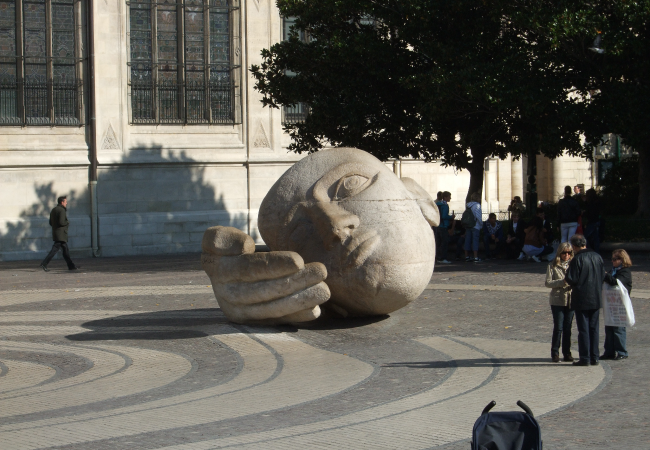
Art in front of Saint Eustache. Photo credit: Hazel Smith
Ancient records situate Saint-Eustache on its present site in 1214, as a small chapel serving the grocery vendors of Les Halles. As Les Halles grew so did a need for a larger church. King François I provided a generous donation toward the church’s construction and the first foundation stone was laid in 1532.
Despite its classical west façade, Saint-Eustache is an example of French Renaissance architecture at its most ornate. The interior with its lofty pillars is grandly impressive. The high altar of white marble and sculpted canopy is equally remarkable. Its earliest examples of stained glass date from 1631. Some pay tribute to Les Halles market with images of pork and wine. The church houses a wealth of artwork, including a painting by Peter Paul Rubens. The church has an active artistic role within the community with many contemporary art installations throughout the year.
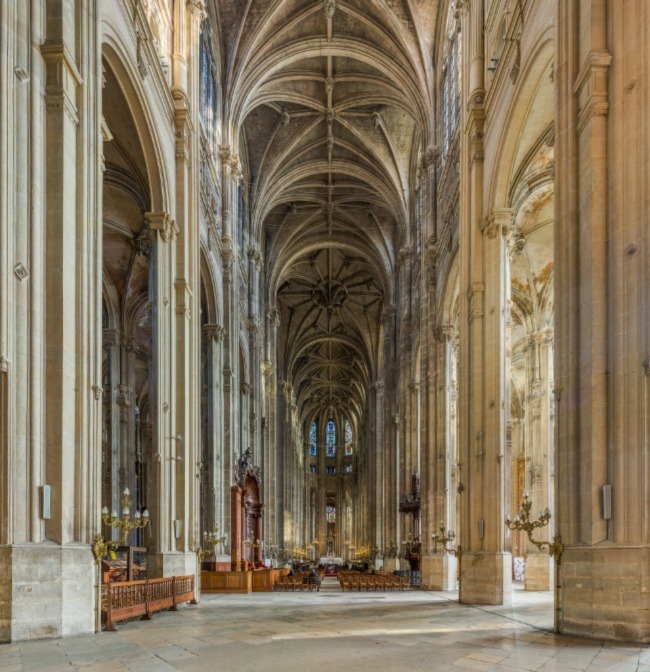
Church of St Eustace Interior, Paris. photo credit: Diliff / Wikimedia Commons
Saint-Eustache’s church organ, which competes in size with that of Notre-Dame, has witnessed Hector Berlioz and Franz Liszt perform some of their finest works. Saint-Eustache held the funerals of the composer Rameau and Mozart’s mother, Anna Maria. Faithful to its musical tradition, the church hosts philharmonic concerts, choirs and year-round music festivals.
This holiday season, there will be an organ recital on December 18 and on Christmas Day itself, featuring classical and contemporary Christmas-themed music.
On Wednesday 21 Dec 2022, at 8:45 p.m., there will be a performance of Christmas masterworks ranging from traditional carols to works by the most important Classical composers, including Bizet, Handel, Mendelssohn, Bach, and Saint-Saëns, performed by the Helios Orchestra.
Address: 146 rue Rambuteau, 1st arrondissement
Saint-Sulpice
With its two mismatched towers, the Church of Saint-Sulpice stands head and shoulders above the Saint-Germain district and can be easily spotted on the horizon of the Left Bank. Next to Notre-Dame, it’s Paris’s second tallest church. An amalgam of different architectural styles, Saint-Sulpice’s towers differ because of a halt to its renovation during the French Revolution and today they remain 18 feet at odds with each other. Saint-Sulpice is a vast church with a façade of sky-high pillars designed by theatrical designer Servandoni, and theatrical it is. The church’s porch fronts onto Place Saint Sulpice where a large fountain is flanked by stony lions. At this time of the year, a Village de Noël encamps on the square.
The present church is the second building on the site, erected over a Romanesque church originally constructed during the 13th century. Between the church’s fluted pillars are chapel niches filled with murals; Delacroix’s Jacob Wrestling the Angel is especially important. However, like many churches of this age, the chapels and niches are in the midst of repair. In some, the paint is peeling or scaffolding is in evidence.
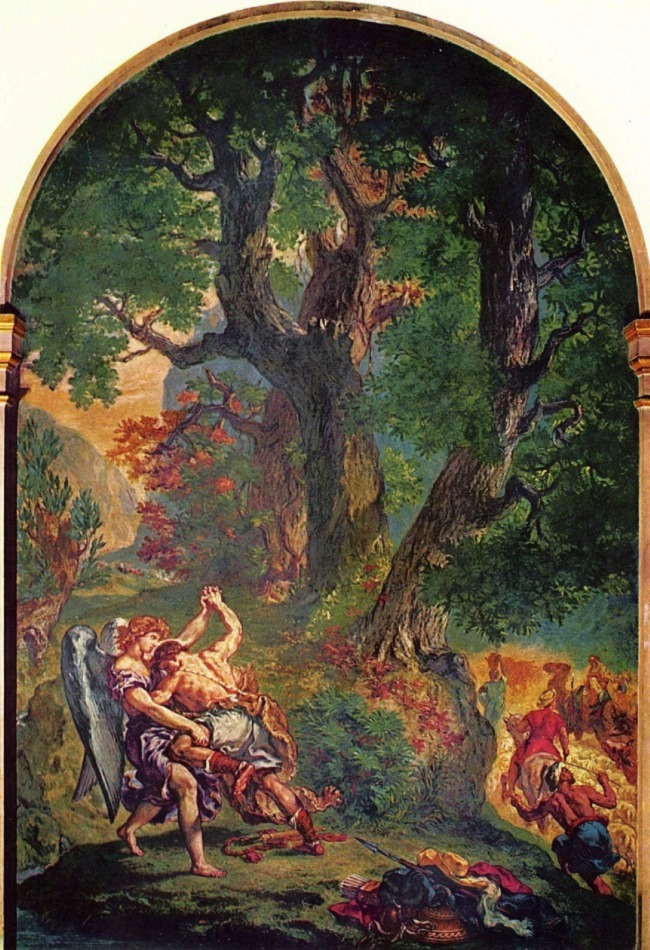
Delacroix’s mural of Jacob wrestling the angel in Saint Sulpice. Wikimedia commons
Curiously, there is an ancient astronomical device in Saint-Sulpice, performing the role of a sundial — the position of the mid-day sun once aided in early astrophysics. However, the Church vigorously denies that this and other secrets have anything to do with The Da Vinci Code.
The Helios Orchestra will be presenting the same amazing celebration of Christmas music as Saint-Eustache, but on Thursday December 22 at 8:45 p.m. There will be Christmas masses throughout Christmas Eve and Christmas Day.
Address: 2 Rue Palatine, 6th arrondissement
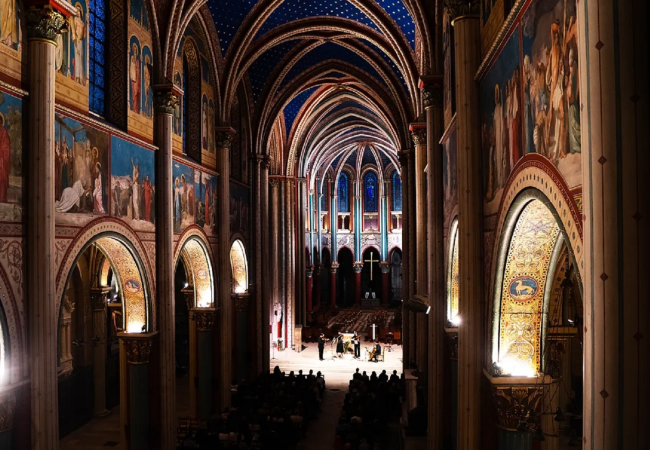
Orchestra Helios at Saint-Germain-de-Prés. Courtesy of Helios
Saint-Germain-de-Prés
Alongside the bustling thoroughfare of Boulevard Saint-Germain, with its high-end shops and historic cafés, is the church which gave the district its name. Saint-Germain-de-Prés once presided over 42,000 acres of land; “de Prés” means “of the meadow.” On this corner, with a hundred people at every turn, it’s hard to picture how empty it once would have been. Saint-Germain-de-Prés is the oldest church in Paris and was once the city’s richest and most dominant religious establishment in Paris until Notre-Dame was completed. Its original buildings dated from the 6th and 7th centuries. The nave and belfry of Saint-Germain are the only major Romanesque structures to survive in the capital city. For many years, Saint-Germain-de-Prés looked more like a stronghold than a place of worship: surrounded by high walls, and at that time, three watchful towers. Even today, we see flying buttresses supporting the heavy stone walls.

Abbaye de Saint-Germain des Prés. Photo credit: DXR/ WIkimedia Commons
The interior of these churches is always surprising. Here, small side doors lead into an unexpected space. Inside its rather foreboding exterior, Saint-Germain-de-Prés feels more like Sainte-Chapelle. It’s compound pillars are multi-colored, and lead into a gorgeous umbrella-ed vault where stars spangle the deep blue ceiling. The arches are beautifully mosaicked and the feeling here is almost Byzantine. Beyond the towering stained glass windows, shrieks are heard: not ghosts, but tiny members of the church’s enclosed daycare.
Known for its great acoustics, the church’s program of Christmas Music includes a concert on Saturday, December 17th, 2022 at 8:30 p.m. of The Four Seasons by Vivaldi, Waltzes and Polkas by Strauss, Caccini’s and Schubert’s Ave Maria performed by the Orchestre Paris Classik and Bertrand Cervera, concertmaster of the Orchestre National de France. The concert will be offered again on December 28th and January 1st, with different solo violinists. A concert will be held on Christmas Day with organist Anne-Marie Blondel playing works by Bach.
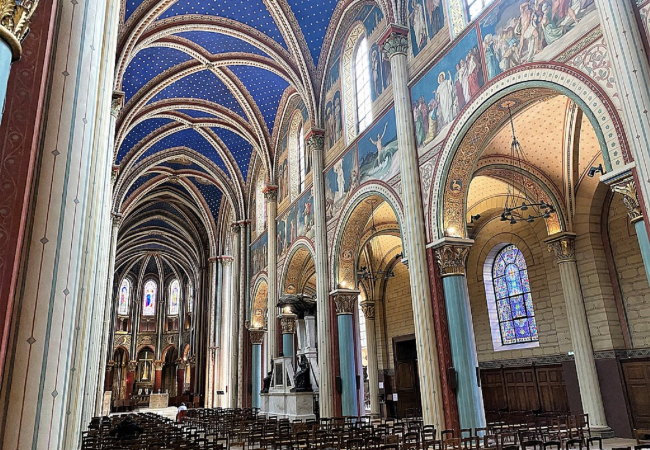
Saint-Germain-du-Prés interior. Photo credit: Cmcmcm1/ Wikimedia Commons
Saint-Paul-Saint-Louis
Behind the large red double doors at no. 99 rue Saint Antoine is the Church of Saint-Paul-Saint Louis. This church had an important influence on Parisian religious architecture. Built in the 1600s, it’s the first church to adopt the Baroque style of the Jesuits and abandon the Gothic completely. Jesuits were once known for their architectural sparseness, but by the 17th century, they adopted a style of decoration distinguished for its embellishment of every available surface with rich materials and sophisticated workmanship.
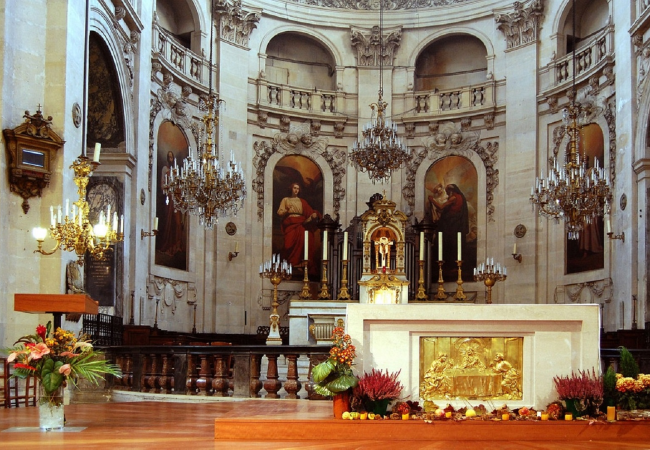
St-Paul-St-Louis church. Photo credit: Pline/ Wikimedia Commons
The church was consecrated in 1641 and Cardinal Richelieu, from the pages of Dumas’ Three Musketeers, delivered its first mass.
The ubiquitous Parisian Victor Hugo donated baptismal fonts made from giant clamshells, giving thanks for his daughter’s wedding service. Their baroque style (almost rococo) ties nicely with the church’s interior space. Victor Hugo’s autograph is kept in the church’s archives as he had to sign his permission for his underage daughter Léopoldine to marry. The transept reveals a fine painting by Delacroix. In addition, there’s an almost illegible piece of graffiti from the late 1700s stating, “Republique Française ou Mort.”

The Church of Saint-Paul-Saint Louis. Photo credit: Chabe01 / Wikimedia Commons
With rays of yellow and blue indicating day and night, the church’s Nocturne clock, seen from the street, is presumed to be the second oldest working clock in Paris. Watchmakers and electricians are trying to electrify this assembly to avoid winding it every eight hours.
At 8:30 p.m. on Friday, December 23rd, there will be a seasonal concert of Vivaldi’s The Four Seasons, Ave Maria and other Christmas songs.
Address: 99, rue Saint Antoine, 4th arrondissement
Église Saint-Louis-en-l’Ile
At No. 21 Rue Saint-Louis-en-l’Ile stands the church whose name extends to the island as a whole. The Église Saint-Louis-en-l’Ile is enduring the racket of renovation, but its pealing bells still cheer the neighborhood. Scaffolding is now blocking up the buildings windows, but the church remains open. Despite the drear on the inside of Saint-Louis-en-l’Ile, the street always seems to lead to the sunrise or sunset. Saint-Louis’s 17th-century interior was once bright and light and one of the richest in Paris, made from a wide variety of expensive materials, many of which were sumptuously gilded. Construction on the Jesuit-style church began in 1644. Its 98-foot tower has an unusual, almost Gaudi-like, spire, perforated to allow the wind to pass through. The church’s clock hangs perpendicular to the street like the shingle from an ancient inn. The French Revolution wreaked destruction on many Paris churches, their interior decoration taken or sacked. The church was extensively restored and redecorated in the 19th century. Bousset, a private citizen who filled the church with many works of art, covered much of the cost. When renovations to Saint-Louis-en-l’Ile are finished, it will again be brilliant and luxurious.
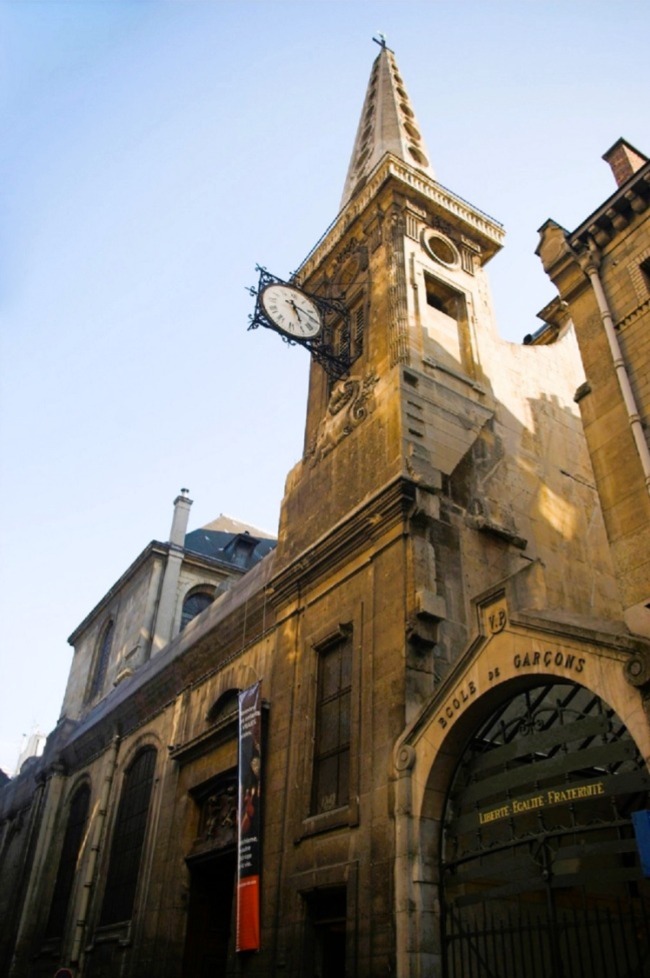
Eglise Saint Louis en l’ile. Photo credit: Fabienkhan / Wikimedia Commons
The church is fully involved with the residents of its Seine-side parish, spreading the word on the street and bestowing local merchants with good wishes at this festive time of year. Meals with others are shared as parishioners open their homes during the days leading to Christmas. Curious friends can be brought to the church’s evening masses, which are followed by conviviality, discussion, and dessert.
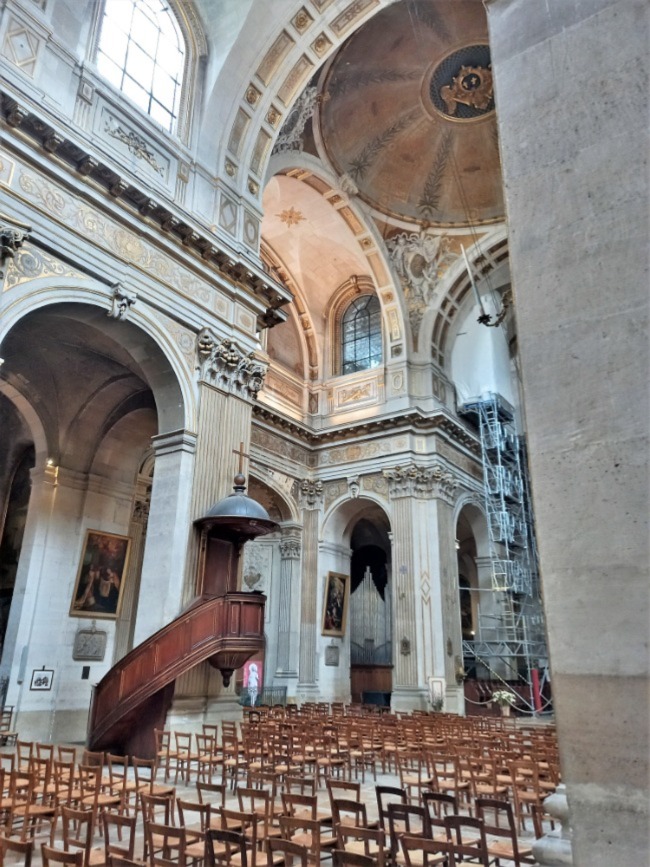
Eglise Saint-Louis-en-Ile. Photo credit: Cmcmcm1 / Wikimedia Commons
Saint-Louis-en-l’Ile has a full calendar of Christmas concerts ranging from vocal ensembles, sacred Basque songs, Mozart’s Exultate Jubilate. Bach’s motets, the polyphonic intonations of Corsica and Georgia, the Grande Veillée de Noël featuring compositions by Schubert, Bach, and Corelli. The opportunity is provided to experience an orthodox service, with traditional chants in Ukrainian. Masses will be held on Christmas Eve and Christmas Day.
Address: 19 Rue Saint-Louis en l’Île, 4th arrondissement
Saint-Séverin
In the lively center of the university district is the ancient church of Saint-Séverin, with its origins in the 6th century. Séverin was a hermit living by the Seine, who cured King Clovis of a disease from which his doctors had no remedy. For this and other healing miracles, a chapel was built in his name on plot of dry land in an otherwise swampy tract in the center of the Latin Quarter. Séverin’s chapel was rebuilt in 1230, then, after a fire, rebuilt again, and enlarged in the 15th to 17th centuries in the Flamboyant Gothic style. It was the parish church for students at the University of Paris, and it grew as the student population of the area grew. The poet Dante may have prayed under Saint-Séverin’s vaulted ceiling. During the French Revolution the church was repurposed as a store house for gunpowder. It now dominates the tourist streets of the Left Bank.

Eglise Saint-Séverin. Photo credit: Mbzt / Wikimedia Commons
Saint-Séverin’s 12th-century bell tower houses the oldest bell in Paris. Still extant are the stained glass windows from the 14th, 15th and 16th centuries. Dating from 1970, Jean Bazaine’s stained glass contribution does a wonderful job complementing the Flamboyant Gothic or flaming design. The vaulted ceiling is a remarkable bit of architecture. Behind the altar are columns that gather the many ribs of the vault into twisted, spiraling bundles. It has readily been compared to a grove of palms. The church reaches out to the community with “Solidarity Winter,” in which they welcome five people to shelter in the presbytery.
The organ at Saint-Séverin was the Paris favorite of 19th-century composer Camille Saint-Saëns. The concert on Christmas day at 9 p.m. will fill the Eglise Saint-Séverin with popular and divine pieces from famous composers such as Bach, Corelli, Schubert, Charpentier, and Telemann. Apart from the amazing organ will be the trumpet and the soprano voice of Sabine Revault d’Allonne. It’s sure to be an exquisite pleasure.
Address: 1 rue des Prêtres-Saint-Séverin, 5th arrondissement
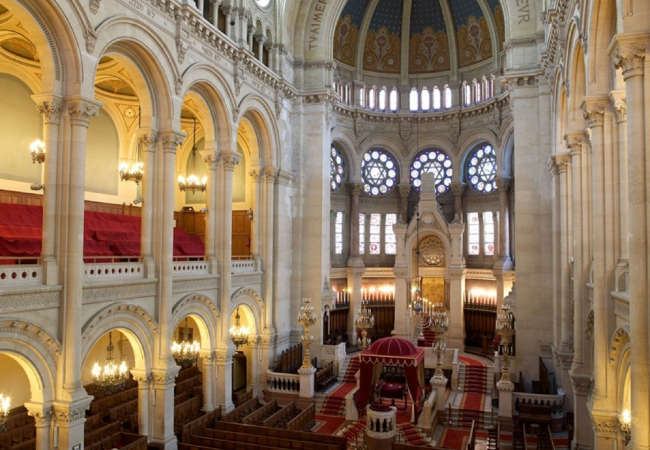
courtesy of the Grand Synagogue
In 2022, Hanukkah runs December 18-26. Throughout Paris there will be public menorah lighting events which often include short blessings, prayers and perhaps a few songs. The first lighting ceremony will take place in front of the Eiffel Tower on a 30-foot menorah.
The Grand Synagogue of Paris, as it name suggests, is the biggest synagogue in the French capital. With a capacity of 1,800, it’s also the second largest synagogue in Europe. Also known as the Synagogue de la Victoire, it was built in a neo-Byzantine style between 1867 and 1874 when Paris’s Jewish community doubled in size. Behind its beautiful 36-meter Romanesque façade, visitors can step inside to discover the long impressive knave, a beautiful rose window, and an inspiring blue and gold vault. Situated in the 9th arrondissement, it is the official seat of the chief rabbi of France and the chief rabbi of Paris. Most of the religious items on display, including the solid silver menorah, were donated by the Rothschild family. The center of the Parisian Jewish community’s spiritual life, the Grande Synagogue de la Victoire is used for official ceremonies and other events throughout the year. Please check the Grande Synagogue website for information.
Address: 44 Rue de la Victoire, 9th arrondissement
In all cases be quiet, respectful, and unobtrusive in these places of worship.
Lead photo credit : Saint-Sulpice. Photo credit: Zairon/ Wikimedia Commons



